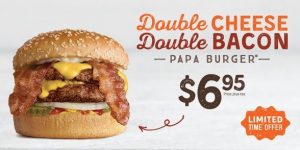Original ad:

Brief analysis of the original ad:
In this A&W ad they have kept the composition relatively simple. The classic A&W orange and brown make it nearly impossible to mistake which fast food chain is reaching out to you. You see a large, flawless burger beside the words in which they are using to draw you in: “Double CHEESE” “Double BACON.” A&W is trying to highlight the best and favorite parts of a burger with capitalized letters, and make sure the viewers know that they are getting twice as much as usual. They are portraying that you can get all of this burger for a small price of $6.95, but there’s a catch, it’s only offered for a limited time only. This makes a consumer feel like they need to try the product while it is still available. A marketing technique that creates a sense of urgency and necessity. The best way to sell something is to make the consumer think they need it. This advertisement emphasizes the advantages of fast food dining, it’s convenient, inexpensive, and tasty.
A&W glamorizes the burger (perhaps by using paint or plastic food), they are making it look more appealing and irresistible. This ad exaggerates how much “double” really is, your burger is not going to look like that in real life, and are you even getting real cheese and bacon? Or is it so washed out in preservatives one can barely call it that? Is this price they advertise even a good deal with what you are actually getting? Consumers will eat fast food due to persuasive advertising techniques like these exaggerated claims like “Double,” as well as creating the feeling of “you need to try it before time is up!”
Fast food advertising influences eating behavior which have major impacts on health. These influences can lead to obesity, other complications that come with unhealthy weight gain as well as unnecessary substantial costs to healthcare systems.
My jammed version of the ad:

My jamming philosophy:
Through my alteration I wanted to create awareness to how fast food industries encourage over-consumption of their products through advertising and serving size; including the repercussions that come along with it.
I tried to reveal that this is not a flawless burger, it probably isn’t even real. By over saturating the burger and making it look bloated I highlighted how advertisements use fake food and exaggerate it to look perfect. Fast food burgers are high in calories, fat, saturated fat, preservatives, sugar and salt; and they are trying to sell you a bigger version of it. This “done up” burger is false advertisement, it looks delicious, and to make it more appealing you get more for your buck, but you need to have it before its gone; all techniques of strategic advertising to pull the consumer in.
The change in text “double chins”, “double bypass”, “papa’s obese”, “millions out of your healthcare system”, and “limit your life expectancy” are all to emphasize the negative and unhealthy effects of obesity in which fast food habits can lead to. Not only is your health at risk if you give in to these advertisements, but so is everyone else’s health who is fooled into these persuasive marketing techniques. This rise in obesity creates increasing costs to healthcare systems that could be avoided all together. North Americans consume so much fast food because of excessive marketing, easy access, convenience, disposable income, as well as family influences. Parents influence their children’s eating habits, if a parent has poor eating behavior it is likely their child will too.
Fast food chains promise quality food at affordable prices which is questionable as superior quality food cannot be created and sold at that cheap of a price.
The truth is, ads can harm public health. Companies try to influence indulgence of unhealthy food and overeating. Being overweight is a risk factor for many different types of cancers, just like tobacco; so why don’t we create tighter regulations on our fast food advertisements?